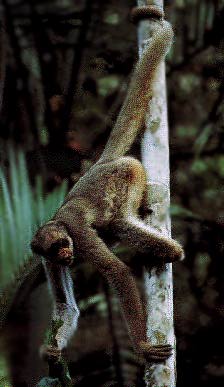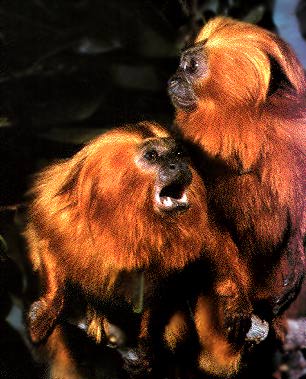
 |
New World Monkeys |
New World Monkeys are found only in South and Central America. Their nose is broad and flat, with the nostrils facing outwards. Many of the New World Monkeys have prehensile tails. A prehensile tail can wrap around a branch and can support the weight of the animal as it hangs. A prehensile tail is used as another limb. New World Monkeys all have a 2-1-3-3 dental formula.
Spider Monkeys (picture above) live in the rain forests found in the Andes Mountain Range. They spend the majority of their time in the highest level of the forest canopy. Spider Monkeys are what are called frugivores, with 90% of their diet consisting of fruits and nuts.
They have a prehensile tail. The arms are much longer than the legs. The thumbs are very small in size and may actually be absent. Spider Monkeys are semi-brachiators. They use their long arms and tail to swing through the trees. The hand is held in a hook grip while swinging.
Group size varies, but there can be troops containing up to 100 individuals. There are more males than females in the groups. Females are responsible for raising the young.
 Tamarins
live in tropical rain forests and are thought to occupy the higher levels
of the forest canopy on small branches.
Tamarins
live in tropical rain forests and are thought to occupy the higher levels
of the forest canopy on small branches.
They eat a wide variety of foods, including insects, fruits, and small lizards.
Tamarins often give birth to twins which is unusual for primates. There is one breeding female in each group. The groups often contain three members. The males take an active role in the rearing of the young. After the first week, the babies are carried by the males. When it is time for the infants to eat, they are handed back to the mother. Each of the two males will carry one baby.
The hands and feet of Tamarins are
narrow in size. All of the digits have modified claws, except for the big
toe which has a flat nail. The third and fourth digits are webbed. They
are quadrapedal in the trees, climbing, walking on top of the branches
and jumping.
 territory
as the spider monkey. They eat leafs, flowers, buds, and fruits. They are
particularly fond of figs. They have a resonance chamber below their lower
jaw. This chamber catches the sounds they make and increases the sound
made. This chamber is how they got their name.
territory
as the spider monkey. They eat leafs, flowers, buds, and fruits. They are
particularly fond of figs. They have a resonance chamber below their lower
jaw. This chamber catches the sounds they make and increases the sound
made. This chamber is how they got their name.
(sound)
They are quadrupedal and have a prehensile tail. They may hang from a branch by their arms or tail, but they do not swing through the trees. They walk on top of the branches.
The average size of the groups is
18 individuals. There are more males than females in a group. Adolescent
males often are found by themselves. Howlers are very territorial. They
protect their territory from others by howling, shaking and breaking branches.
They rarely fight. There is no clear dominante male, even during the time
a female is sexually receptive. The males as well as the females will help
an infant bridge a gap between two branches, or retrieve them if they fall.